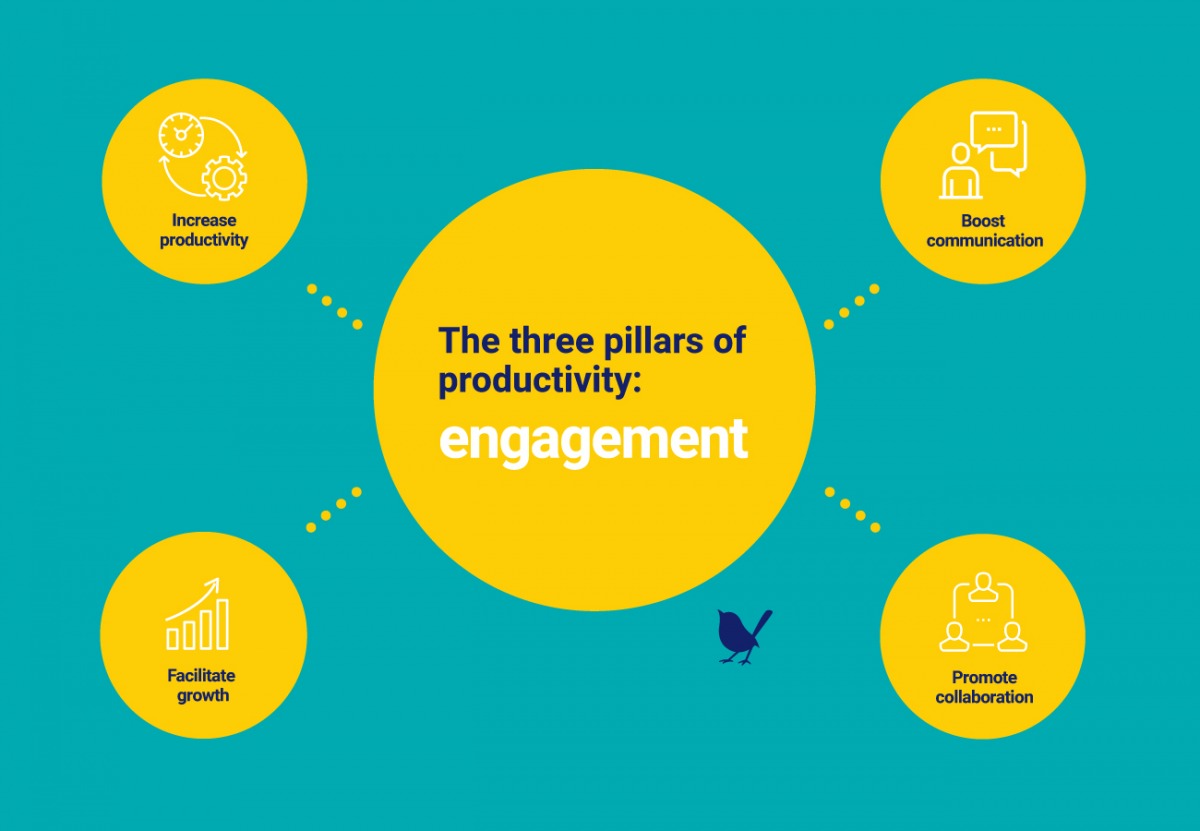The three pillars of productivity: engagement
30 January 2018

Business as usual is not an option. With the rate of change, and the pressures to produce more with less, businesses must embrace digital technology to improve productivity and compete successfully.
But just because your business is ticking along doesn’t mean it’s doing so productively. Blockages to productivity become inherent in process and get tolerated over time. This needn’t be the case. Each of the three pillars of productivity represent a cornerstone your business must embrace if you want to free up your resources and unlock your potential.
The first of these pillars is “engagement”.
Why boost engagement?
Engagement is more than just communicating an idea. It’s facilitating ways and means for staff, customers and suppliers to communicate conveniently and efficiently. Facilitating a two-way dialogue is essential for business development and growth.
Research conducted by Harter, Schmidt and Hayes found employees who were more engaged were up to 51% more productive. By improving engagement, your organisation can adapt and react more rapidly. This agility promotes rapid feedback and leads to a more efficient and productive organisation.
Providing different ways of communication, outside of sending an email, stops your team being a slave to their inbox. Emails are designed to transfer information, not to facilitate dialogue. People communicate through a wide array of tools, from Skype to Slack to SMS, and as time progresses so do the modes available.
What was once a phone is now a powerful computer capable of rapid data transfer, whether that’s images on Snapchat or quick communication via Messenger. Being a modern tool doesn’t mean its exclusively for the latest generation, but it can mean it’s solutions are cutting edge. Engaging people isn’t as simple as sending an email anymore. Reach your audience where they interact, whether that’s through social media or via any multitude of apps available from their pocket.
Inside your business, that may feel like emails. But incorporating an instant messenger, for example, gives you access to rapid feedback and real-time communication. It opens a more dynamic and engaging channel for feedback and, externally, gives customers a route of communication more convenient to them.
Boosting engagement with your people
Internally, software can be used to facilitate easy and efficient communication between colleagues. Take an intranet, such as Crest our employee engagement platform, for example. We develop a bespoke intranet to not only serve as a client’s company notice board, centralising memos and upcoming events, but to:
- improve visibility of staff calendars
- incorporate live social and news feeds
- store key company documents
- track staff performance
- monitor incoming leads
- automatically notify colleagues by tagging them in posts
…the capabilities are vast.
Facilitating real-time communication
An intranet can also promote engagement through an integrated instant messenger. The standalone application, Slack is one of several business tools that facilitates real-time conversation. You can create private channels to discuss specific projects, keep all stakeholders in the loop and promote collaboration. You can even grant access to clients to gain a clearer visibility of a project’s progress.
Engaging customers for business growth
Customer feedback is essential for business growth. Enabling customers to conveniently give feedback highlights strengths and weaknesses in your service directly from the people who use it, allowing you to react and adapt your offering. In doing so, you can continually seek to improve, develop and grow your business.
Such feedback can be furthered through software, like our Net Promotor Score (NPS) tool, Lentl. NPS is a globally recognised customer satisfaction metric that can be used to predict customer behaviour. The higher the score, the more loyal the customer and the more likely they are to engage positively with your business in future. And vice versa. Software, such a Lentl, facilitates this two-way communication, simplifying the feedback process for the consumer and giving measurable value to the collected data for the business.
These tools make it possible to conveniently ask an individual, who has previously engaged with your business, to feedback on how likely they are to recommend the service to a friend of colleague. Understanding this allows you to track the performance of your business and more granular aspects, like departments.
Not only does facilitating communication, collaboration and visibility promote a more positive work culture, they are aspects that customers are increasingly accustomed to. Being able to offer them is part of the modern business landscape, and gives competitive advantage over those who don’t adapt.
If you would like to discuss how your business can embrace digital transformation, just get in touch.
Discover the remaining two pillars of productivity by checking back on the Blue Wren blog or attending the event, below.
Update: these articles are linked in the Further Reading section of this blog
Boosting workplace productivity networking event
Get tickets to the next Hoppers Business Network event: held Friday 2nd February 2018, 8am-10am. I’ll be hosting the event, discussing the three pillars of productivity and how they can be implemented to boost your workplace productivity.

Categories
Productivity
In this article learn how software:
- boosts productivity
- saves your business money
- removes the reliance on time-sapping emails
- promotes a positive collaborative culture
- facilitates the sharing of ideas
- makes communication easier
- removes blockages to information sharing
Further reading:
- Key productivity metrics and how to measure them
- 5 signs that your processes are holding you back
- Why your business needs to embrace digital transformation
- 8 steps to process improvement for a growing business
- The three pillars of productivity: integration
- The three pillars of productivity: process improvement
- How bespoke software boosts productivity
- How software promotes a positive culture in the workplace
- Bespoke software vs off-the-shelf software

